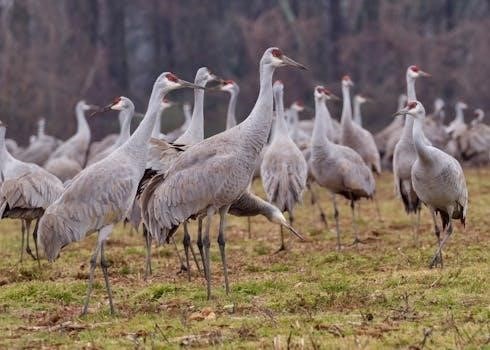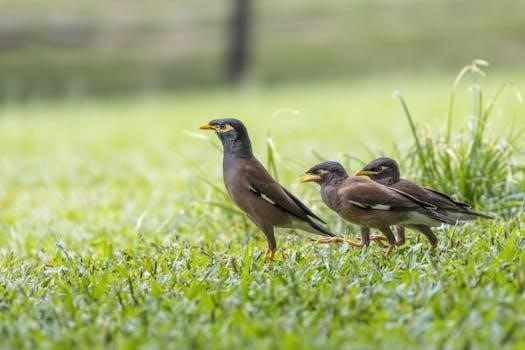birds of michigan field guide
Spot a mystery bird? Our Michigan birds field guide makes identification easy! Explore stunning photos and learn about local species. Start your birding adventure now!
Michigan’s diverse habitats host over 400 bird species‚ from common backyard visitors to rare migrants․ This rich avian life offers fantastic opportunities for birdwatching․ A field guide is an essential tool for identifying these varied birds and learning about their habitats․
Overview of Michigan’s Avian Diversity
Michigan boasts a remarkable avian diversity‚ with over 450 recorded bird species‚ including both resident and migratory birds․ The state’s varied landscapes‚ ranging from dense forests to open farmlands and expansive shorelines‚ provide habitats for a wide array of feathered creatures․ Many species‚ like the American Robin and Black-capped Chickadee‚ are year-round residents‚ while others‚ including numerous warblers‚ pass through during migration․ The diversity extends from common backyard birds to majestic raptors and various waterfowl․ Understanding this rich tapestry of avian life is essential for effective birdwatching and conservation efforts․ With such a variety‚ Michigan offers bird enthusiasts endless opportunities for discovery and appreciation․

Key Identification Features
Identifying birds involves noting key characteristics like size‚ shape‚ and color patterns․ Understanding these features‚ along with habitat and behavior‚ helps distinguish different species‚ especially in Michigan’s diverse bird population․
Using Field Guides for Bird ID
A field guide is an indispensable tool for bird identification‚ providing essential information for both novice and experienced birders․ Choose a guide specific to Michigan or the eastern United States for accurate species representation․ These guides offer detailed descriptions‚ including identification tips‚ range maps‚ and habitat preferences․ Many guides also feature photographs or illustrations and‚ in some cases‚ audio clips to help recognize bird calls․ Start by focusing on size and shape‚ then move to color patterns․ Pay attention to the bill type and body shape‚ as these are key features․ Field guides often organize birds by family or visual similarity‚ making it easier to narrow down possibilities․ Always cross-reference multiple features for accurate identification․ Online resources and smartphone apps are also available‚ often supplementing traditional guides with updated sightings and user-friendly search tools․
Importance of Size and Shape in Identification
When identifying birds‚ size and shape are crucial initial steps that help you narrow down the possibilities before considering color․ Start by comparing the unknown bird to a familiar species‚ such as a robin or chickadee‚ to gauge its approximate size․ Pay attention to the overall body shape‚ noting if the bird is plump or slender‚ has a long or short tail‚ and a large or small head․ The shape of the bill is also a critical indicator; is it conical‚ straight‚ curved‚ or hooked? Consider the bird’s posture and any distinctive features‚ such as a crest or long legs․ These structural characteristics are often more reliable than color‚ which can vary with age‚ sex‚ and lighting․ Size and shape provide a fundamental framework for accurate identification․
Recognizing Color Patterns and Plumage
After assessing size and shape‚ observing color patterns and plumage details is the next key step in bird identification․ Note the dominant colors and where they appear on the bird‚ such as a bright red breast‚ black cap‚ or white wing patches․ Look for distinct patterns‚ like stripes‚ spots‚ or bars on the wings‚ back‚ or tail․ Remember that plumage can vary by age and sex‚ so consider whether you’re seeing a male‚ female‚ or juvenile bird․ Pay attention to subtle differences in shading and feather texture․ Some birds display iridescence or have differently colored wing linings․ Use field guides to compare your observations to known species and carefully note all the details of the bird’s coloring and feather patterns․

Common Michigan Birds
Michigan’s birdlife includes familiar species like the American Robin and Black-capped Chickadee․ The vibrant Northern Cardinal is also commonly seen․ These birds can be observed in various habitats throughout the state․
American Robin⁚ Identification and Range
The American Robin is a key species for comparison when identifying other birds due to its familiar size and shape․ They measure approximately 10 inches from bill to tail‚ similar to a Blue Jay‚ but smaller than a Mourning Dove․ Robins have a plump body and a fairly long tail‚ with a straight‚ slender bill that curves at the tip․ Their plumage features gray-brown upperparts and a distinctive rusty orange breast․ These birds are year-round residents in southern Michigan‚ while they are summer residents only in the northern regions of the state․ They inhabit open woodlands‚ farmlands‚ urban parks‚ and lawns‚ often seen hopping on the ground in search of food․
Black-capped Chickadee⁚ Habitat and Behavior
The Black-capped Chickadee is a common backyard bird found throughout Michigan year-round․ They are small‚ about the same size as an American Goldfinch‚ with a round body‚ a large‚ round head‚ and a long tail with a rounded tip․ Their plumage is gray above‚ buffy below‚ and they have a black cap and bib with white lower face․ These active birds inhabit deciduous and mixed forests‚ flitting from tree to tree‚ gleaning insects from twig tips․ In winter‚ they form the core of mixed-species flocks alongside nuthatches‚ kinglets‚ and woodpeckers․ They are known for their acrobatic movements and constant activity․

Northern Cardinal⁚ Attracting to Feeders
The Northern Cardinal is a popular backyard bird in Michigan‚ recognized by its bright red color (males) and gray with hints of red (females)․ Cardinals are year-round residents in shrubby woodland edges and are easily attracted to feeders with black oil sunflower seeds․ They have a plump body‚ a long full tail‚ and a wispy crest with a short‚ heavy‚ conical pink bill perfect for cracking seeds․ They are often seen at larger hopper or tray feeders where they eat various seeds‚ berries‚ and nuts․ Providing a variety of food and a good feeder setup can increase the likelihood of attracting these beautiful birds to your yard․

Birdwatching Resources
Many resources assist bird enthusiasts in Michigan․ These include online tools‚ smartphone apps with identification features‚ and local birding hotspots․ These tools enhance birdwatching experiences and learning․
Online Tools and Smartphone Apps
Numerous online resources and smartphone applications greatly aid bird identification in Michigan․ These digital tools often provide comprehensive species information‚ including identification tips‚ range maps‚ habitat details‚ high-quality photographs‚ and audio clips of bird songs and calls․ Some apps are designed for beginners‚ offering easy-to-use search functions to help identify birds based on basic characteristics․ Others are geared toward experienced birders‚ allowing for more precise identification based on location and date․ Electronic field guides‚ for example‚ can contain information on hundreds of bird species‚ making identification accessible and convenient․ These digital resources enhance the birdwatching experience‚ whether you are in your backyard or exploring a local hotspot․ They provide a wealth of information at your fingertips‚ making it easier than ever to learn about Michigan’s diverse avian population․
Local Birding Hotspots in Michigan
Michigan offers numerous prime locations for birdwatching‚ each with unique habitats attracting a variety of species․ From the Detroit River International Wildlife Refuge‚ known for its diverse birdlife‚ to local parks and nature preserves‚ the state is rich with opportunities․ These hotspots often feature trails‚ observation points‚ and sometimes even visitor centers‚ enhancing the birding experience․ Exploring areas near lakes‚ forests‚ and urban environments can reveal different species․ Birding clubs and organizations often provide information on specific locations and guided tours for those wanting to learn more․ The eBird platform can be used to find local hotspots‚ with recent sightings and photos shared by other birders․ These locations offer a chance to see different species and improve your bird identification skills․

